Sexual reproduction
Sexual reproduction involves the joining of two sex cells (gametes) – the sperm (male gamete) and the egg/ovum (female gamete) to make a baby.
The male reproductive system
The male reproductive systemThe organs and tissues involved in producing offspring. makes spermThe male sex cell or gamete. and delivers it into the female reproductive system.
Sperm are specialised cells highly adapted for their function.
Their adaptations include:
A tail – called a flagellum – allowing it to swim through the female reproductive system.
A haploidA cell that contains half the normal number of chromosomes. nucleus – containing half the normal number of chromosonesThe structure made of DNA that codes for all the characteristics of an organism..
Many mitochondriaThe site of cell respiration. to produce energy.
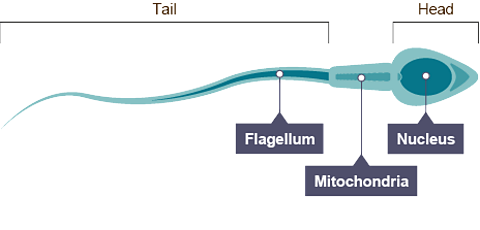
The female reproductive system
The female reproductive system makes and releases eggs/ova.
It also protects and nourishes the foetus until birth.
Fertilisation and pregnancy
Fertilisation occurs in the oviductA tube in the female reproductive organ through which an egg passes from an ovary to the uterus..
Fertilisation is the fusion of a haploid sperm nucleus and a haploid egg nucleus to form a diploid (normal chromosome number) zygote.
A zygote is the first cell of a new individual.
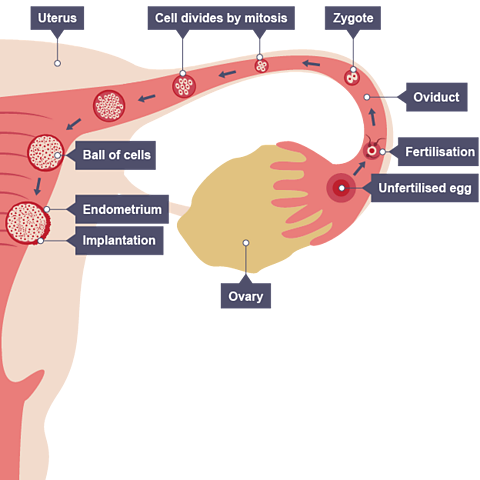
After fertilisation:
The zygote travels down the oviduct dividing by mitosisA type of cell division that produces cells that are genetically identical to the parent cell and to each other. to form a ball of cells (embryoAn organism in the early stages of development.).
Implantation occurs when the embryo reaches the uterusAlso known as a womb. This is where the fertilised egg (ovum) develops. and attaches to its thick lining to receive nourishment.
The placentaThe organ in the uterus of pregnant mammals that allows the transfer of nutrients and waste products between the mother and the foetus through the umbilical cord., umbilical cordThe cord that connects the foetus to the placenta. It contains blood vessels., amnionBag surrounding the foetus in the uterus and containing the amniotic fluid. and amniotic fluidThe fluid surrounding a foetus that cushions it. form.
The embryo differentiates to produce a variety of tissues and organs.
The embryo is referred to as a foetus when all its organs start to form.
Placenta and umbilical cord
The placenta allows substances to diffuse from the mother’s blood to the foetus (eg oxygen and glucose).
Waste substances diffuse from the foetus to the mother’s blood (eg carbon dioxide and ureaA nitrogenous waste product resulting from the breakdown of proteins. It is excreted in urine.).
The placenta is adapted for diffusion by having:
a large surface area for exchange between it and the uterus wall.
villi (finger like projections that extend into the uterus wall), which further increase the surface area of the placenta.
a good blood supply.
The umbilical cord attaches the placenta to the foetus. It contains the umbilical artery and the umbilical vein.
The umbilical artery carries urea and carbon dioxide from the foetus to the mother’s blood.
The umbilical vein carries oxygen and nutrients from the mother’s blood to the foetus.
maternalBelonging to the mother. blood and foetalBelonging to the foetus. blood systems are close together but not joined. They are separated by thin membranes that allow diffusion to occur.
Amnion and amniotic fluid
The amnion is a membrane that forms around the embryo.
Amniotic fluid surrounds the embryo inside the amnion, cushioning and protecting the developing embryo.
Sex hormones
The testesThe plural form of testis, the male organ that produces sperm. produce testosteroneMale sex hormone produced in the testes, which is responsible for puberty in boys..
The ovariesA pair of organs in the female reproductive system where ova (eggs) and hormones are produced. produce oestrogen.
These hormones cause secondary sexual characteristics to develop at pubertyThe physical changes a child’s body goes through when developing into an adult..
| Male | Female | Both |
|---|---|---|
| Testes enlarge | Sexual organs enlarge and breasts develop | Body and pubic hair grows |
| Body becomes more muscular | Pelvis and hips widen | Sexual awareness and sex drive increase |
| Voice deepens | Menstruation begins |
The menstrual cycle
The menstrual cycle prepares the female reproductive system for pregnancy and it occurs from pubertyThe physical changes a child’s body goes through when developing into an adult. until approximately age 50.
It is controlled by the hormones oestrogenA female sex hormone produced in the ovaries, which is responsible for puberty in girls and the regulation of the menstrual cycle. and progesteroneSex hormone produced by the ovaries and placenta..
A 28 day cycle:
Days 1-5
Menstruation occurs – theuterusAlso known as a womb. This is where the fertilised egg (ovum) develops. lining breaks down and is released through the vaginaA muscular tube that leads from the cervix to the outside of a woman's body..
Oestrogen levels are low.
Progesterone levels are low.
Days 6-13
- Oestrogen increases causing the initial repair of the uterus lining and its buildup.
Day 14
- The egg is released and this is called ovulation. It happens after oestrogen levels peak.
Days 15-28
Progesterone levels peak after ovulation to maintain the thick uterus lining.
If no pregnancy occurs, hormone levels decrease and the cycle restarts.
A woman can get pregnant if spermThe male sex cell or gamete. are present in the oviduct a few days before or after ovulation (day 14), if it fertilises an egg.
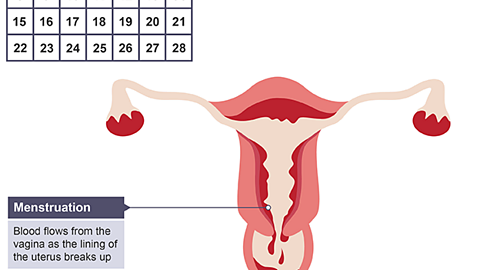
Image caption, Days 1 - 5
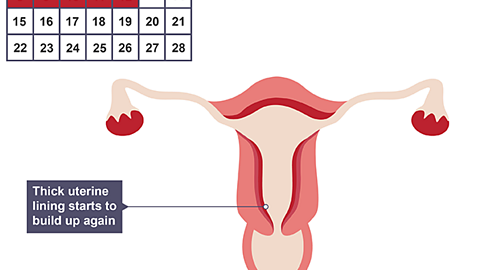
Image caption, Days 6 - 12

Image caption, Days 11 - 12
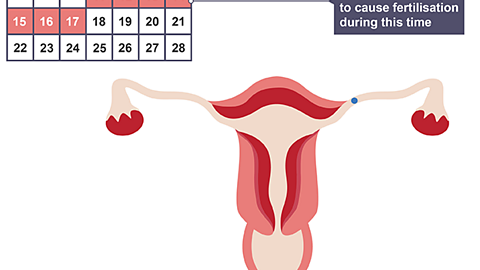
Image caption, Days 11 - 17
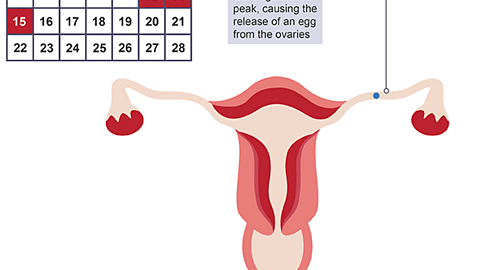
Image caption, Days 13 - 15
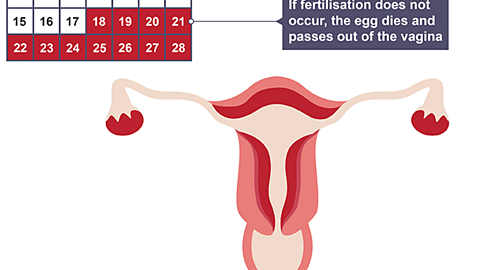
Image caption, Days 18 - 28
1 of 6
Infertility
What are the causes of female infertility?
OvariesA pair of organs in the female reproductive system where ova (eggs) and hormones are produced. don’t produce eggs.
Blocked/twisted oviductA tube in the female reproductive organ through which an egg passes from an ovary to the uterus. (maybe due to infection).
Complication from a previous STIA sexually transmitted infection. (for example, chlamydia)
UterusAlso known as a womb. This is where the fertilised egg (ovum) develops. lining not developing enough to allow embryo implantationIn reproduction, when the fertilised egg attaches to, and embeds itself in the wall of the uterus..
VaginaA muscular tube that leads from the cervix to the outside of a woman's body. too hostile to allow spermThe male sex cell or gamete. to enter (eg too acidic).
What are the causes of male infertility?
Not enough sperm produced.
Non-healthy sperm produced (can be due to smoking or drinking alcohol to excess).
Impotence.
What are the treatments for infertility?
Fertility drugs
Hormones are given to a woman to increase the production of eggs.
This may solve the problem but only if low egg production was the issue.
IVF – in vitro fertilisation
Process:
A woman is given fertility drugs to increase egg production.
Eggs are surgically collected from the ovariesA pair of organs in the female reproductive system where ova (eggs) and hormones are produced..
SpermThe male sex cell or gamete. is collected.
Sperm and egg cells are mixed in the lab.
The woman is given hormones to ensure the uterusAlso known as a womb. This is where the fertilised egg (ovum) develops. lining is thick.
EmbryosAn organism in the early stages of development. are placed into the uterus.
If successful an embryo/embryos will implant into the uterus lining – the woman is pregnant.
Explaining the IVF process
Contraception
There are mechanical, chemical, surgical and natural contraceptive methods used to prevent a pregnancy.
Mechanical
| Example | Method | Advantage | Disadvantage |
|---|---|---|---|
| Male condom | A barrier that prevents sperm entering the vagina | Easily obtained. Protects against STIs (eg HIV) | Unreliable if not used properly. |
| Female condom | A barrier that prevents sperm passing up the female reproductive system | Protects against STIs (eg HIV) | Unreliable if not used properly |
Chemical
| Example | Method | Advantage | Disadvantage |
|---|---|---|---|
| Contraceptive pill | Taken regularly by a woman. Prevents ovulation by changing hormone levels. | Very reliable. | Essential to remember to take the pill. Side effects include weight gain, mood swings or an increased risk of blood clots. Does not protect against STIs. |
| Contraceptive implant | A small tube placed under the skin of the upper arm. Releases hormones slowly over a long period of time. Prevents ovulation. | Very reliable. Can work for up to three years. | Does not protect against STIs. Can prevent menstruation. |
Surgical
| Example | Method | Advantage | Disadvantage |
|---|---|---|---|
| Vasectomy | Sperm tubes are cut preventing sperm entering the penis. | Virtually 100% reliable. | Difficult or impossible to reverse. |
| Female sterilisation | Oviducts are cut preventing fertilisation. | Virtually 100% reliable. | Difficult or impossible to reverse. |
Natural
| Example | Method | Advantage | Disadvantage |
|---|---|---|---|
| Rhythm method | Sexual intercourse is avoided around the time of ovulation. | No chemicals are used. | Not as reliable as other methods, especially if the menstrual cycle is irregular. |
The natural method is chosen by some groups opposed to contraception for religious or ethical reasons.
Test your knowledge
Human reproduction interactive
Play this game to explore human reproduction and the stages of pregnancy.
More on Body systems
Find out more by working through a topic
- count1 of 3
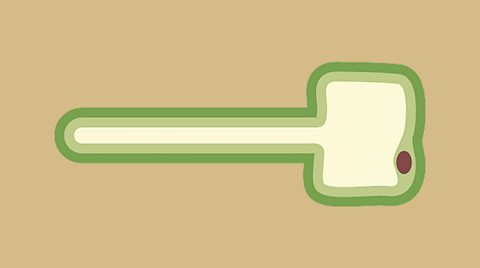
- count2 of 3
